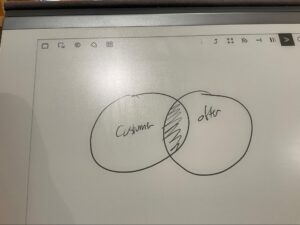Strategy and Your Story

Strategy. A word that made Bill Bain and Mitt Romney a LOT of money. It also didn’t hurt most of the CEOs who hired these guys.
But it’s often ignored, even though, I’ve written about it so wonderfully in relation to Narcos: Mexico and how the service academies play college football. And yes, about Tennessee football. Sigh. My work never ends.
Let me give you another view on strategery, this time, beginning with 5th-grade flag football.
Don’t bail yet – we’re going to wind up looking at levers you can pull on strategy, and one you can pull within days without breaking your business.

My 11-year-old son plays flag football because all he wants to do is… play football. So after watching his last team keep throwing incomplete passes 25 yards downfield, I said, “Crap. I’ll do this thing.” And I said I’d coach him. (There’s also a lesson in humility coming here…)
Having coached high school football, I learned a few things over the years that might help in coaching 4th and 5th graders. My dream was the ability to run the speed option, knowing it would lead to broken ankles all over the field (that’s a term for kids falling down, not actually fractured bones).
It took me one practice to realize the speed O wasn’t going to happen. And it was sort of made worthless if the ball couldn’t be lateralled past the line of scrimmage. So I settled on 4 passing concepts we could run with a couple of run plays.
Two games later, I realized our kids didn’t understand situational football (i.e. last play of the half, at midfield, down by 1 score, don’t throw a dump off, but go deep – there’s nothing to lose), and that they weren’t going to become good at my vaunted I9 Air Raid in 40 minutes of practice.
My inner Will Ferrell from Kicking and Screaming is starting to settle some.

We’ve cut the passing concepts down. And then, realizing our QB was developing some touch, but was inconsistent at best, we began running the ball more. And we’re winning more.
(In case you’re wondering, we ball out on defense, averaging 3 takeaways per game. Cover 3 – it’s amazing.)
We’re now back in contention for the playoffs, with a shot to make a run.
Because we:
- Looked at our resources in talent and time
- Considered our competition
We’ve been able to develop a winning formula: simple passing concepts, run repeatedly (because the other team doesn’t adjust on defense); a basic run game with motion; and stout defense. It’s working. And it’s evolving.
I have had to adjust from what I wanted and what I have done before, based on the realities I’m encountering.
Let me give another example.
The Market Decides the Strategy
For almost 2 years, I worked with a boutique P&C and health brokerage. They had a very tight ideal client profile. And it was a client bigger competition didn’t want (usually too small), and that smaller competition wasn’t doing a great job serving.
Only one problem: there are about 1,000 of these customers out there, and the market isn’t growing.
The CEO had seen models of salespeople running 7 touch systems (reaching out to a prospect 7 times to get a conversation and then a meeting) and put it into practice. It was great. For about 2 years.
Then….the reps were calling on the same people, again. They had talked to them 8 months ago and didn’t know how to audible in the line.
The approach to the market didn’t fit the market. For Hubspot and Salesforce, they can run a 7 touch system all day because their total addressable market is nearly infinite.
However, if your market is small and limited, you can’t run a cold call play on the same people every year.
So this firm adapted and moved to an account-based selling model. If you don’t know what that means, just think of it like this: they went to a relationship-building plan to win customers. They knew it would take 12-36 months to win most accounts, so they prioritized those they believed they had the best chance of winning, and put in place plans to get in with each CEO and/or CFO of those accounts. They’d still call some, but also visit in person, invite those people to events, and find other ways to engage.
They changed their approach to the market, meaning, how they get customers to acquire them.
Options in Strategy
One option, that my client employed, was picking a different customer. The offer was slightly different, but the biggest strategic decision they made was picking a certain, specific customer.
Their Venn diagram looked like this. Their customer and offer overlapped well.
They could offer the same solutions as everyone else, but they made some changes for that customer and then focused on them really well.
What some of their competition has done is create different offerings. This is often the case in service or tech businesses. It *may* be a different solution, but sometimes it’s simply a matter of pricing or delivering said solution in a novel format.
A company might offer a subscription plan instead of using a break-fix model. In wealth management, they may go to fee-based vs. assets under management. Or in insurance, put in place a captive plan.
My client had a specific customer, and a slightly different offer (they use a captive). But they began to experiment with a different go-to-market strategy. They went from using a tech playbook to one more suited to winning a limited number of accounts.
The diagram here might look like this: THAT customer with THIS offer and OUR GTM plan….
Any of those three can be adjusted, with varying degrees of difficulty depending on the industry. Sometimes it’s an easy but slow pivot to a new customer. Other times, it’s very hard. Sometimes migrating a GTM approach isn’t that cumbersome. For my client, it involved some planning and resource allocation, but it wasn’t a one-year process. Another client of mine made some small changes to their GTM – one that was simply a matter of tweaking their sales funnel – and it produced multiple of new opportunities. Changing the offer is maybe the most challenging, especially for service businesses, so it takes more forethought…something many owners and operators feel like they don’t have time for.
All that matters, though, is that the company finds a way to win. One that works for them.
For many of my clients – law firms, consultants, and various tech companies – their offers and customer are really undifferentiated. They realize this, and usually, so do their customers/clients.
Some, like a company in the wireless space I did some work with, need to make a change long term to maintain their profit margins and revenue. Not to grow – but to maintain. That’ll take a minimum of 12 months, and likely closer to 24-36 to hammer out.
There is a way to carve out for yourself an advantage, at least for a time. And while it’ll appear to be sleight of hand, it’s actually more potent than it appears at first glance.
Telling a Better Story
Often, your GTM and offer are dictated by your resources. Which may force you to tell a better story.
Don’t be scared by my rendering of the sweet spot in the middle. It’s not exactly to scale.
Here’s what I mean about your story. It’s not about your origin, or your “why?” though those matter in some ways. I’m just not qualified to speak to them.
Your story is often a way of talking to your market. You might call it your message.
On this front, your competition is probably lousy. I know because when I research my client’s competitors, I fall asleep reading their nonsense.
It doesn’t connect. Most companies and businesses are talking about themselves.
When they need to be talking TO their ideal customers. But not just TO them while talking about themselves.
They need to be talking to them about the narrative their ideal customers have in their own heads.
Let me give an example. I’m doing more and more work with law firms. When people call law firms, they EXPECT to get a dissertation on the law, which they don’t really want. But to those skilled with a hammer, everything’s a nail.
What potential clients are feeling when they call an attorney is fear, disappointment, and anxiety. What they are thinking is, “I need help.” What they are worried about with an attorney is whether or not this person will fight for them, care about them, and well, return their calls.
But the attorneys jump into talking about the law and precedent and options. When all they need to do (and this is simplified for the sake of the example) is market themselves as, “The attorneys who call you back,” and in their first conversation with a potential client say, “Look, I get it. This is scary, and you’re probably wondering, ‘Will this person fight for me? Will they care? Do they get what I’m going through? Can I count on them?’ We get it.”
Admittedly, the story doesn’t address the economics of a customer (not immediately, anyway), and may not impact traffic (though it can, if done well in the right channels). It’s most effective at conversion – that point where a potential customer or client is in front of us, and we have a chance to connect and build the case for, “Why us?”
What do you do with this?
Think about your own conversions right now: are you winning enough of the right opportunities you get? If not, consider that it’s not a product or offering issue, though it could be. And it’s likely NOT a customer issue, though it could be.
It may simply be the story you’re telling. Reframe your conversations like this:
- Move from discussing features of your offering to understanding and speaking in-depth about the problems your customers/clients have
- Move from talking about your successes to telling stories about customers who came to you: what they were experiencing, worried about, wanting
- Move from telling people how great you are to demonstrating familiarity with those issues
- Move from using your internal language to that of your common customer, or stop trying to impress people with your vocabulary
This raises the question: when do I talk about me or my services?
To which I respond, “You won’t have to do that much. It’s implied in your demonstrated understanding of their problems.”
They’ll assume you’re the expert, and because you look, sound, and feel different, you’ll win them over, along with their money.
Not all the time, but for many of you, enough to impact sales and cash flow.
This seems overly simplistic. And in some ways, it’s simple. Hard, but simple.
It’s also something your competitors likely won’t do. A lot of money is made by actually putting into practice what we learn, rather than simply consuming information. This is true here, too.
You’ll want to have this mindset about a different story or conversation flow through your sales calls with potential clients, from tone to length to structure, but for now, addressing how you talk about yourself, your business and your offerings is enough.






